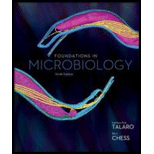
1. Biologists can set up an ecosystem in a small, sealed aquarium that continues to function without maintenance for years. Describe the minimum biotic and abiotic components it must contain to remain balanced and stable.
To determine:
The minimum abiotic and biotic components required to maintain a balanced and stable sealed aquarium for years.
Introduction:
To maintain a balanced and stable sealed aquarium, it has to act like an aquatic ecosystem. It should contain the adequate and required abiotic and biotic components. A sealed aquarium ay be thought of as a mini lake and hence a similar kind of ecosystem needs to be created.
Explanation of Solution
The concept of creating is a sealed aquarium is similar to making a nature aquarium. The major requirements are primary producers, consisting of phytoplankton, algae and diatoms. Consumers such as zooplanktons, small and large fishes are required and decomposer microbes are must. There should be appropriate amount of sunlight or artificial light that can help in photosynthesis along with supply of oxygen and carbon dioxide. An artificial bedrock also needs to be created.
Hence, it may be concluded that, an artificial sealed aquarium needs appropriate abiotic and biotic components.
Want to see more full solutions like this?
Chapter 26 Solutions
Foundations in Microbiology
- 3)"Ecosystem engineers" are a special group of keystone species a)True b)Falsearrow_forwardThe health of an ecosystem is typically measured by look at its level of ___, or the variation of organisms living there. I have already asked the question, but the answer was wrong....arrow_forwardAn organism is able to live well in its environment because of special characteristics called * a) Abiotic factors B) Biotic factors C)Aggregates D)Adaptationsarrow_forward
- Biologists can set up an ecosystem in a small, sealed aquarium that continues to function without maintenance for years. Describe the minimum biotic and abiotic components it must contain to remain balanced and stable.arrow_forwardChoose TWO (2) different types of ecosystem, in your surrounding area. The area can be in your yard or in your neighbourhood, which is easily accessible to you. a) the two types of ecosystems that can be identified during the observation b) abiotic and biotic factors in each ecosystem (FOUR examples ofinteractions).arrow_forwardAn ecologist hiking up a mountain may notice different biomes along the way due to changes in all of the following except: elevation rainfall latitude temperaturearrow_forward
- The study of nutrient cycling though the environment is an example of which of the following? organismal ecology population ecology community ecology ecosystem ecologyarrow_forwardThe ability of an ecosystem to return to its equilibrium state after an environmental disturbance is called.__________ resistance restoration reformation resiliencearrow_forwardWhich biome experiences the highest annual rainfall? a. tropical rainforest b. tropical savanna c. chaparral d. temperature grassland e. arctic tundraarrow_forward
- The quantitative estimate of the total amount of living material is called (a) biomass (b) energy flow (c) gross primary productivity (d) plant respiration (e) net primary productivityarrow_forwardThe primary producers in an ocean grazing food web are usually._________ plants animals fungi phytoplanktonarrow_forwardWith antibiotic resistance rising, researchers are looking for ways to reduce use of these drugs. Some cattle once fed antibiotic-laced food now get probiotic feed that can bolster population of helpful bacteria in the animal's gut. The idea is that if a large population of beneficial bacteria is in place, then harmful bacteria cannot become established or thrive. Which ecological principle is guiding this practice?arrow_forward
 Biology 2eBiologyISBN:9781947172517Author:Matthew Douglas, Jung Choi, Mary Ann ClarkPublisher:OpenStax
Biology 2eBiologyISBN:9781947172517Author:Matthew Douglas, Jung Choi, Mary Ann ClarkPublisher:OpenStax Biology: The Dynamic Science (MindTap Course List)BiologyISBN:9781305389892Author:Peter J. Russell, Paul E. Hertz, Beverly McMillanPublisher:Cengage Learning
Biology: The Dynamic Science (MindTap Course List)BiologyISBN:9781305389892Author:Peter J. Russell, Paul E. Hertz, Beverly McMillanPublisher:Cengage Learning Biology: The Unity and Diversity of Life (MindTap...BiologyISBN:9781305073951Author:Cecie Starr, Ralph Taggart, Christine Evers, Lisa StarrPublisher:Cengage Learning
Biology: The Unity and Diversity of Life (MindTap...BiologyISBN:9781305073951Author:Cecie Starr, Ralph Taggart, Christine Evers, Lisa StarrPublisher:Cengage Learning Biology (MindTap Course List)BiologyISBN:9781337392938Author:Eldra Solomon, Charles Martin, Diana W. Martin, Linda R. BergPublisher:Cengage Learning
Biology (MindTap Course List)BiologyISBN:9781337392938Author:Eldra Solomon, Charles Martin, Diana W. Martin, Linda R. BergPublisher:Cengage Learning



